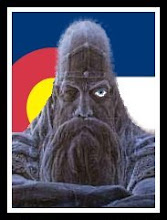

Its a Big Mountain.....a REALLY BIG Mountain. The massif of Mt. Silverheels is three miles (4.8 klics) in diameter above 12,000 feet (3,600 m.). She stands alone, distinct from her more famous Mosquito Range big brothers, the famous 14'ers: Mt.Lincoln, Mt.Bross and Quandary Peak. Still, Silverheels is high, 13,822 ft, (4213 m.) and a gorgeous peak from all sides.

From the 9'200 ft. (2,800 m) floor of South Park the peak runs along the western side of the Park. She is a gentle giant, rising in a slow swell above the valley floor, marking the division between the Tarryall Creek drainage and the South Platte River drainage. Both rivers converge at Eleven Mile Canyon on the far nor'eastern end of South Park.

Mount Silverheels was named after a dance hall girl who was called Silverheels because of the German Silver decorations on her dancing shoes. Evidently, during an epidemic of smallpox in the nearby mining camp of "Buckskin Joe", she was the only woman who stayed in town to care for the ailing miners. The story is told that she worked tirelessly to tend for the sick until she contracted the pox. Whether she died or was so disfigured that she no longer felt she was desirable is not known. However, she did disappear. The survivors took up collection. They raised $5,000 to help her. When the town fathers went to give the gift, they found her cabin deserted. No one ever saw her again.
Legend has it that there is still a beautiful ghost of a woman, dressed all in black who visits when the veil between the worlds is thin. She leaves flowers on certain graves in Buckskin Joe. And yes, she has bright silver heels on her shoes. Her memory lives on, it seems, along with a selfless spirit of caring.

Mt. Silverheels is not an easy climb simply because the massif is large. It requires a long, long approach time. Unless of course, you have a good, high clearance 4WD vehicle. There is a poorly marked road that heads out of Fairplay that will take you close enough to the summit to make a picnic lunch hike....at 13,000 ft. (4,000 m.) if you can find the trail....and if the capricious weather has left open the the 4WD road.

Most people know Mt. Silverheels as just another peak to the north of Highway 9 between Fairplay, Hoosier Pass and Breckenridge. Further north, there is another road that leads past Mt. Silverheels. That would be the seasonal road leading over Boreas Pass (11,481 ft./3499 m.)out of the little town of Como. Boreas Pass was a simple horse path until cut and raised as a narrow gauge railroad track in the late 1800's by the Denver, South Park and Pacific R.R. and later widened into a stage coach road.
Yours truly on the Boreas Pass road at the 10k ft (3050 m.) overlook on a blustery day in early July of 2008. Silverheels is in the back ground. There is still a good amount of snow on the peaks and ridges.
There are remnants of the town of Boreas at the summit of the pass. It was a railroad encampment manned by maintenance workers who toiled to keep the rail passage open during frequent and brutal winter storms. It is now maintained by the National Forest Service and the Summit County Historic Society. The railroad, a division of the Union Pacific, ran from Breckenridge and Leadville into Como where there was a large roundhouse and maintenance facility. Remains of the Roundhouse still exist, an historic site, almost a 120 years later.
What does this have to do with the road to Jerusalem?
Well beloved, the tale of a dance hall girl who gave up her worldly life to serve the sick, knowing full well that she would probably contract a deadly disease, that in itself is indicative of God's Holy Spirit at work in a most unlikely place, within a most unlikely character. To have a beautiful mountain named in her honor calls us to recollect and celebrate other unlikely, worldly angels and mostly unknown folk.
There is another name associated with Boreas Pass. It is the ghost town of Dyersville just to the north of the summit. It is named after... "Methodist minister and prospector John Lewis Dyer, better known as "Father" Dyer, built a cabin in a secluded location along the upper reaches of Indiana Creek in January 1881. He was soon joined in his seclusion by miners and merchants connected to the nearby Warrior's Mark mine. The community named itself after its first resident, Father Dyer." - Wikipedia
~~~~~*~~~~~

Father John Lewis Dyer 1812-1901
"John Dyer, a hearty man of God, skied his preaching circuits in pursuit of his religious commitments.
Dyer was one of the first Methodist ministers to tour Colorado's high country mining camps. He came to Denver, Colorado, from Minnesota in 1861. In Denver, he received orders to take over the Blue River Mission in Summit County, Colorado, in 1862. The following year, 1863, he received new orders and a new circuit. The new circuit encompassed Park City (Alma), Fairplay and Leadville. John Dyer was 50 years old when he began the mining camp circuits and he became acquainted with Norwegian snowshoes from split pine logs. The tips were boiled and turned up for his trips over 13,188 foot Mosquito Range where snow often drifted 20 feet deep.
For 20 years, Father John Lewis Dyer preached the circuit traveling from mining camp to mining camp. As a result, he became known as the 'Snowshoe Itinerant.' The title 'Father' was given to him because of his concern for the people." - The Colorado Ski Museum.
~~~~~*~~~~~
Yeup, beloved...The road to Jerusalem can lead us through some strange places, introducing us to God's servants where we least expect them.




.jpg)












